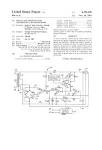| Date | Text | |
|---|---|---|
13 Jul 1937

Water softener patent |
Water softener patent In 1937, a patent was issued to Leroy C. Lind for the Servisoft water softener (U.S. No. 2,087,157). The invention used a regeneratable granulated mineral, such as zeolite, which was already in use by domestic water softening systems using a permanent bed of the material. Leroy Lind devised a method that would be easier and faster to maintain. It would be less costly, and enabled the spent mineral to be regenerated collectively from a number of installations at a central location. The softener was packaged in water pervious, flexible walled cartridges or sacks sized to stack several vertically within a tall cylindrical tank connected to the water supply line. The contents of the sacks would settle to seal against the interior surface of the tank. The tank had a removable top to facilitate switching with renewed sacks. |
|
13 Jul 1937

Henry Edward Armstrong |
death Henry Edward Armstrong Died 13 Jul 1937 at age 89 (born 6 May 1848). English organic chemist whose major research in substitution reactions of naphthalene was important to the synthetic-dye industry. In early work, he developed a method for sanitary surveys of water supplies by determining the organic impurities (sewage) content, which helped to control typhoid fever. Later, Armstrong also pioneered in organic crystallography, and the understanding of the chemical composition of camphor and related terpene compounds. He also devised a centric formula for benzene. Armstrong challenged Arrhenius's ionic theory, proposing instead that water is a complex saturated with the gas “hydrone.” He maintained that vapor pressure was a measure of the concentration of free hydrone molecules. |